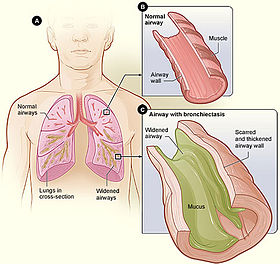Bronchiectasis
| Bronchiectasis | |
|---|---|

Figure A shows a cross-section of the lungs with normal airways and widened airways. Figure B shows a cross-section of a normal airway. Figure C shows a cross-section of an airway with bronchiectasis.
|
|
| Specialty | pulmonology |
| Usual onset | gradual |
| Duration | long term |
| Causes | infections, cystic fibrosis |
| Diagnostic method | CT scan |
| Treatment | antibiotics, bronchodilators, lung transplant |
| Frequency | 1–250 per 250,000 adults |
| Classification | |
|---|---|
| External resources |
Bronchiectasis is a disease in which there is permanent enlargement of parts of the airways of the lung. Symptoms typically include a chronic cough productive of mucus. Other symptoms include shortness of breath, coughing up blood, and chest pain. Wheezing and nail clubbing may also occur. Those with the disease often get frequent lung infections.
Bronchiectasis may result from a number of infective and acquired causes, including pneumonia, tuberculosis, immune system problems, and cystic fibrosis. Cystic fibrosis eventually results in severe bronchiectasis in nearly all cases. The cause in 10-50% of those without cystic fibrosis is unknown. The mechanism of disease is breakdown of the airways due to an excessive inflammatory response. Involved airways (bronchi) become enlarged and thus less able to clear secretions. These secretions increase the amount of bacteria in the lungs, result in airway blockage and further breakdown of the airways. It is classified as an obstructive lung disease, along with chronic obstructive pulmonary disease and asthma. The diagnosis is suspected based on a person's symptoms and confirmed using computed tomography.Cultures of the mucus produced may be useful to determine treatment in those who have acute worsening and at least once a year.
Worsening may occur due to infection and in these cases antibiotics are recommended. Typical antibiotics used include amoxicillin, erythromycin, or doxycycline. Antibiotics may also be used to prevent worsening of disease. Airway clearance techniques, a type of physical therapy, are recommended.Medications to dilate the airways may be useful in some but the evidence is not very good. The use of inhaled steroids has not been found to be useful. Surgery, while commonly done, has not been well studied.Lung transplantation may be an option in those with very severe disease. While the disease may cause significant health problems most people with the disease do well.
...
Wikipedia
